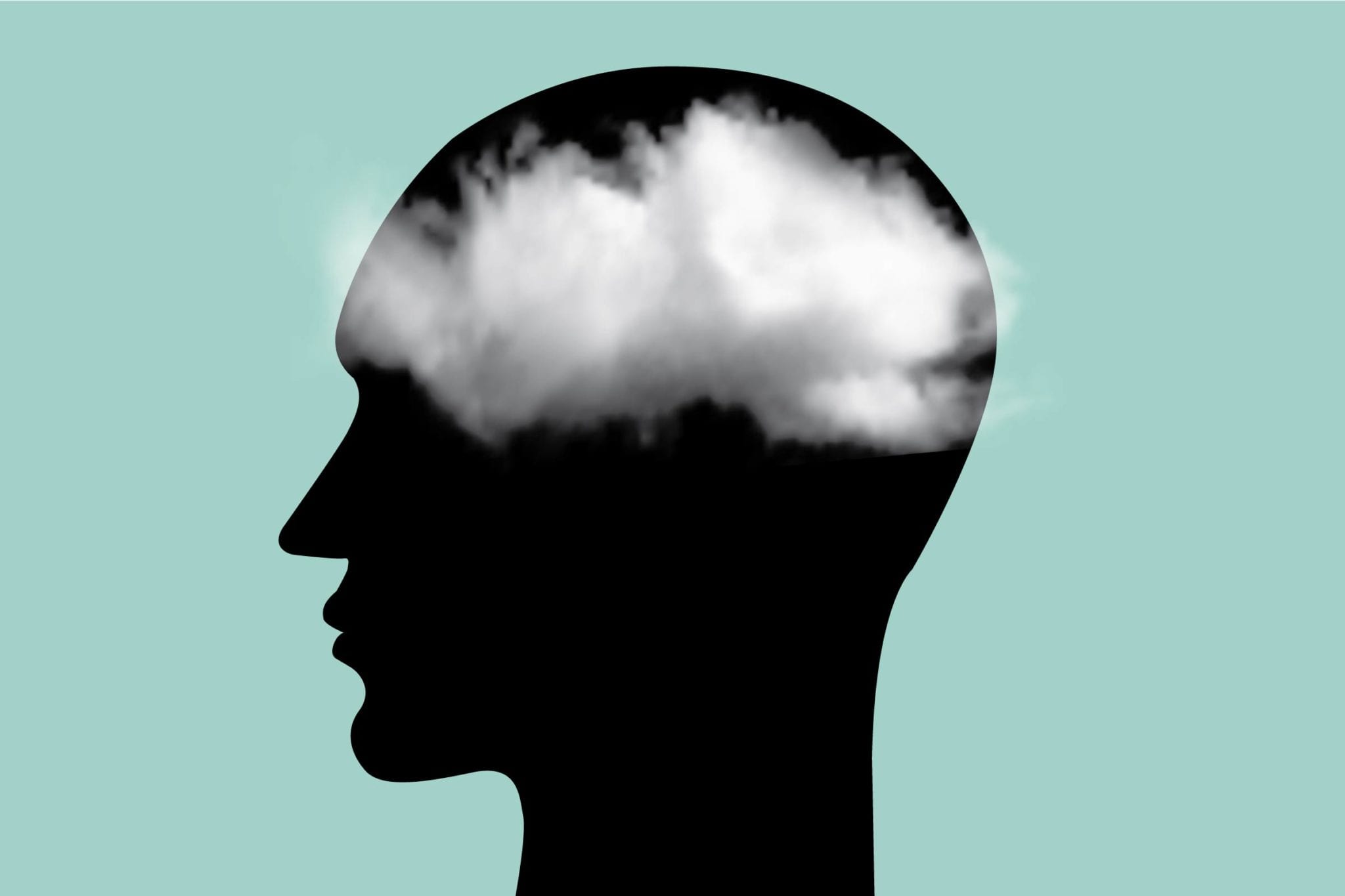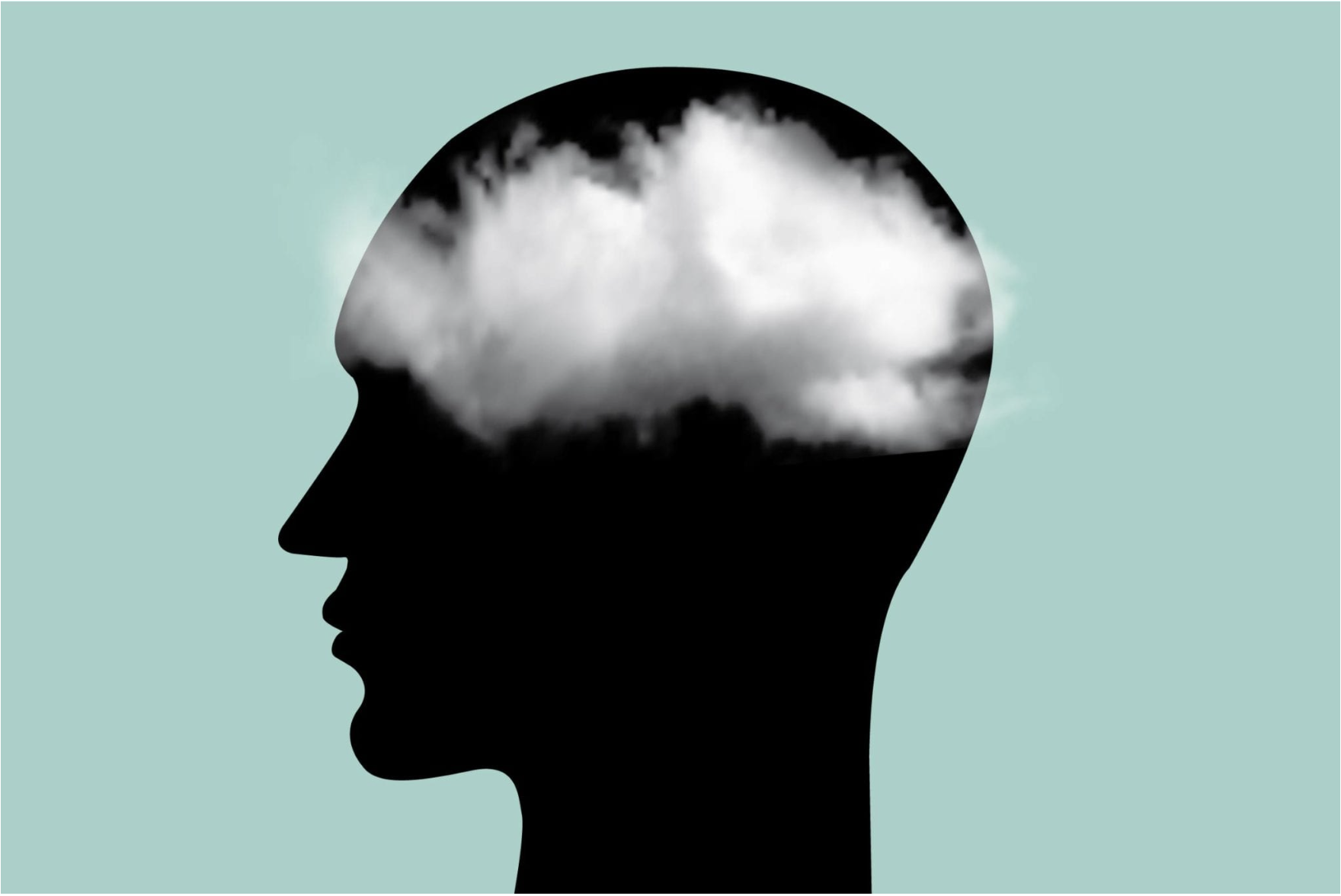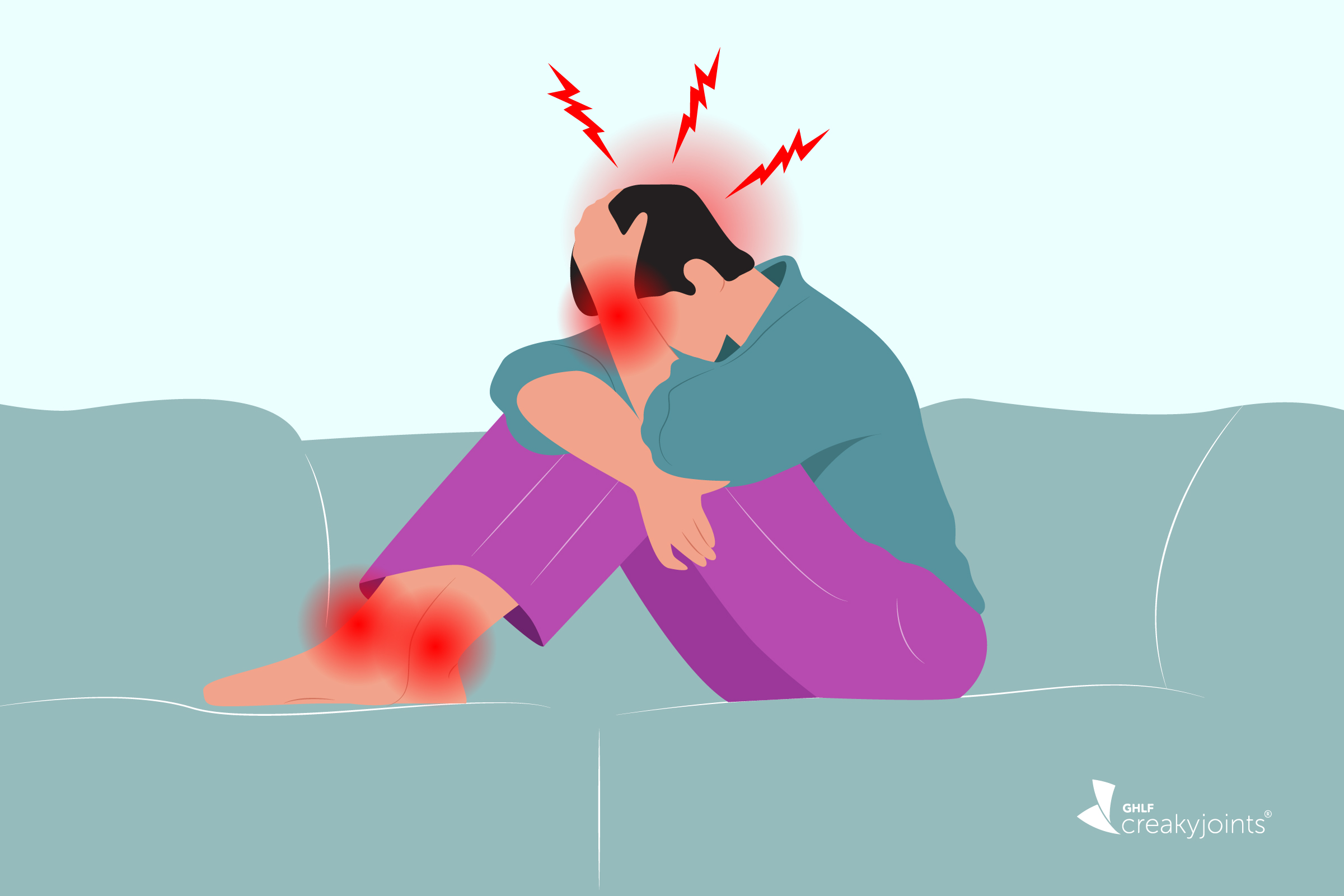The Up-End Migraine Project reveals key gaps in episodic migraine care, aiming to drive change and improve treatment options for patients through insights from both providers and patients.
Migraine and Brain Fog: What It Feels Like, How to Cope
Migraine and Brain Fog: What It Feels Like, How to Cope
April 19, 2024
Nina Wasserman

If you live with migraine and experience confusion, disconnected thoughts, inability to focus, loss of memory, or a feeling of heaviness in your head — you may be dealing with brain fog.
Brain fog is a common symptom of migraine that can happen before, during, and after a migraine attack. “You have to think about the words you have to say,” says Sarah Shaw, Associate Director, Diversity, Equity and Inclusion, at GHLF who co-hosts the Talking Head Pain podcast and is often fuzzy and groggy during and days after a migraine attack. “I’ll be in a meeting, and I will completely lose my train of thought mid-sentence,” she says. “It happens so frequently so I just shrug it off as part of what living with migraine means.”
Migraine is the second leading cause of disability globally. It’s a neurological condition that can have a significant impact on your quality of life. Often experienced as a severe, throbbing pain, sometimes on one side of the head, it can be accompanied by nausea and extreme sensitivity to light and sounds. The attacks can last from four hours to days.
Brain fog can manifest differently in each person. Some common ways people experience brain fog include:
- Difficulty focusing
- Difficulty finding words
- Feeling distracted
- Inability to think clearly
- Inattentiveness to tasks
Not everyone who experiences migraine attacks has brain fog. People with high frequency migraine or chronic migraine (more than 15 times a month) are more likely to experience brain fog, says MaryAnn Mays, MD, neurologist at the Center for Neurological Restoration at Cleveland Clinic.
Thankfully, brain fog is temporary. “It’s not neurodegenerative,” says Dr. Mays. “It’s reversible.”
What Triggers Brain Fog?
It is thought that brain fog is linked to something called cortical spreading depression (CSD), which is an electrophysiological event described as a wave of neuron inactivation that spreads across the cortex of the brain, usually from back to front, according to the Journal of Headache and Pain. As it moves over your brain it suppresses brain activity, slowing your thinking and making it hard to find words, hence feeling like you are in a fog.
While CSD may be the cause of brain fog, it is not really understood why it happens. “We don’t really know what triggers CSD,” says Dr. Mays. But it may be linked to what triggers a migraine in the first place. Brain fog can be an early warning sign that a migraine is coming on.
Migraine triggers come from many sources, both internal and external. The National Institutes of Health (NIH) identifies a top-10 list of migraine triggers. Part of understanding your condition is knowing your triggers, so you can better manage your migraine and prevent future attacks. As for the triggers you can’t avoid — knowing them will help you be prepared so you can find relief.
Here is the list of the 10 most common triggers:
- Drinking alcohol
- Environment: lights, sounds, smells
- Foods such as fermented, pickled, processed, or cured items
- Hormones (related to menstruation and pregnancy)
- Medication overuse known as medication adaptation headache)
- Skipping meals
- Smoking and tobacco
- Stress
- Too much or too little sleep
- Weather changes
Brain Fog in the Phases of a Migraine
According to the American Migraine Foundation, migraine has four phases. Brain fog typically begins on or before the prodrome phase but can also be experienced in any of the phases.
- Prodrome phase: occurs up to 48 hours before a headache. No pain is felt at this time, but symptoms include yawning, fatigue, mood changes, increased urination, difficulty concentrating, and neck stiffness, according to a review published in 2022 in the journal Atencion Primaria.
- Aura phase: about one third of people with migraine have this neurological symptom. There are three types of aura: sensory, language, and visual. The most common type is visual, which causes blurry vision, flashing lights, and blind spots.
- Headache phase: this is where the pain is felt — sometimes unbearable, debilitating pain. The intensity of the headache can increase progressively or feel like an explosive onset. Head movement can be intolerable. There can be nausea and vomiting as well as an aversion to touch, light, sounds, and smell.
- Postdrome phase: this is what is known as the “migraine hangover.” About 80 percent of people with migraine have postdrome symptoms, including tiredness, drowsiness, and sensitivity to noise.
Brain fog can begin as early as 48 hours before the headache phase and as much as 24 hours after the pain has subsided.
What Brain Fog Feels Like
Shaw says that a task that normally takes 30 to 40 minutes can take two or three hours. It’s also hard to use everyday vocabulary. “The other day I could not come up with the word for what I use to protect my hair when I sleep. It was bonnet, but I could not remember the word,” says Shaw. During her early 20s, when her brain fog was its worse, she recalls having difficulty remembering the steps to start her car, her social security number, and how to add.
At one point, Shaw experienced brain fog along with a migraine up to 20 times a month, but “the silver lining is that it doesn’t last,” she says.
A 2023 study published in the journal Headache used the Migraine Clinical Outcome Assessment System to delve deeper into the patient perspective of what brain fog feels like. In the study, 90 percent of participants experienced cognitive impairment before their migraine began in the prodrome phase, 88 percent had it during, and 68 percent still felt the effects in the postdrome phase. About one-third had brain fog between attacks, known as an interictal episode.
The cognitive issues that participants in the study reported fell into four categories:
- Language and speech production, included problems talking and listening, remembering words, and articulation.
- Sustained attention, described as fogginess, fuzzy-headedness, confusion, and disorientedness.
- Memory, which was felt during all phases of an attack and impacted all areas of life such as work, school, driving, home, and parenting.
- Executive function, which caused difficulty processing information and resulted in a reduced capacity for planning and making decisions.
Treating Brain Fog
The best way to treat brain fog is to reduce migraine symptoms, according to the American Migraine Foundation.
Acute or Rescue Treatment
Once your migraine has been triggered, treating it effectively can prevent it from becoming worse. If you can catch it in the prodrome phase, you may be able to prevent or reduce the severity of your migraine. If you do not have a treatment plan, talk to your health care provider about what you can do.
Here are some of the medications used to treat migraine once it has been triggered.
- Over-the-counter medications include acetaminophen or nonsteroidal anti-inflammatory drugs such as naproxen or ibuprofen. These are first-line treatments for mild to moderate migraine attacks. Some combinations of these drugs are available and may include caffeine, which can make them more effective. These remedies, while readily available, should be used with caution because they can cause medication overuse headache — a condition in which overuse of a medication can increase the frequency of attacks, according to the NIH. If you are taking OTC medications more than three times a week to treat migraine, it may be a good time to talk to your health care provider about preventative treatment.
- Triptans are for moderate to severe migraine. Triptans cause blood vessel constriction and should not be used by people with a history of stroke or cardiovascular disease. There are seven triptans available, according to the 2022 review.
- Gepants, also called calcitonin gene-related peptide (CGRP) inhibitors, block the CGRP protein that is known to cause pain. Gepants can be considered as a first-line option for treatment and have no cardiovascular or stroke risk.
- Ditans work as a 5-HT1F receptor agonist without the cardiovascular risk.
Preventative Treatment
Migraine attacks and brain fog can disrupt your life and prevent you from accomplishing even your most basic daily tasks. Preventative therapy can dial back the pain and frequency of migraine and minimize the effects of brain fog.
The American Headache Society (AHS) recently released an updated consensus statement, which was published in Headache: The Journal of Head and Face Pain, that suggests therapies targeting calcitonin gene-related peptide (CGRP), which include monoclonal antibodies (erenumab, fremanezumab, galcanezumab, and eptinezumab) and small-molecule CGRP receptor antagonists (rimegepant and atogepant), as a first-line option for preventing migraine attacks.
There is a growing list of options for prophylactically treating chronic migraine, according to the Cleveland Clinic, including:
- Angiotensin II receptor blockers relax the blood vessel, so the blood flows more freely.
- Beta-blockers slow down cell activity and lower blood pressure.
- Anti-seizure medications work by calming overactive nerves in the body.
- Botulinum toxin injections are injected into the facial muscles and interfere with pain transmission.
- Antidepressants increase serotonin and norepinephrine in the brain, which play a role in pain.
- Monoclonal antibodies that are CGRP inhibitors stimulate the immune system. Some drugs in this class can be given by monthly injection or an infusion given as outpatient care.
- Nerve stimulation in the vagus nerve, supraorbital nerves (forehead) or occipital nerve (back of head) is a hand-held device that can reduce the frequency or duration of a migraine.
- Transcranial magnetic stimulation uses a magnetic field to influence brain activity is a noninvasive therapy.
How to Deal with Brain Fog
Keeping a detailed diary of your migraine and episodes of brain fog can give you information about your triggers and help you and your health care provider find the best treatment.
Things to note about your migraine in your diary:
- Date
- Time of day
- Intensity (mild to severely debilitating)
- Location (one-sided, behind eyes)
- Duration
- Symptoms (both before, during, and after)
- Possible triggers, including foods, hydration, weather, activities, sleep problems, significant events, menstrual cycle, etc.
- Medication
Dr. Mays says a good planner or app that lets you detail all the things you need to do can help you cope with the memory challenges of brain fog. She also recommends exercise, a good night’s sleep, and a healthy diet.
How One Patient Copes
Shaw has developed her own methods of working with brain fog and adapting to her disability. Here is what she suggests:
- Remind yourself to slow down. This is Shaw’s most important advice. Stress and pressure will only make a migraine and brain fog worse. Take on one task at a time, if possible.
- Have patience with yourself. Brain fog may cause you to make mistakes, so remember to give yourself grace.
- Be honest. Tell others you might be having a difficult day and set expectations to take some of the pressure off.
- Rely on your loved ones. Shaw lets her partner know when she is struggling so that she can get the support she needs.
- Manage your expectations. You may not be able to accomplish everything on your agenda when a migraine unexpectedly hits.
- Take a break. Get up, walk around, step outside — change your environment somehow. Shaw says this brings her some relief.
Hear From More Experts and Patients Living with Migraine
Talking Head Pain is a podcast that confronts head pain, head on. Brought to you by the Global Healthy Living Foundation and hosted by migraine advocate Joe Coe, this show explores how people living with migraine, cluster headache, and other types of intense pain find ways to better manage their disease. Listen here.
Sources:
Interview with Dr. MaryAnn Mays, MD, neurologist at the Center for Neurological Restoration at Cleveland Clinic.
Adams A, et al. Chronic Migraine Epidemiology and Outcomes – International (CaMEO-I) Study: Methods and multi-country baseline findings for diagnosis rates and care. Cephalagia. June 14, 2023. doi: https://journals.sagepub.com/doi/10.1177/03331024231180611?icid=int.sj-full-text.citing-articles.482.
Aguilar-Shea A, et al. Migraine review for general practice. Atencion Primaria. February 2022. https://www.sciencedirect.com/science/article/pii/S0212656721002420?via%3Dihub.
Gerstein M, et al. Patient-reported experiences with migraine-related cognitive symptoms: Results of the MiCOAS qualitative study. Headache. March 2023. https://pubmed.ncbi.nlm.nih.gov/36905166/.
Ha H, et al. Migraine Headache Prophylaxis. American Family Physician. January 1, 2019. https://www.aafp.org/pubs/afp/issues/2019/0101/p17.html#:~:text=Some%20indications%20for%20preventive%20therapy,%2C%20and%20medication%2Doveruse%20headaches.
Harriet A, et al. Spreading depression as a preclinical model of migraine. The Journal of Headache and Pain. May 2, 2019. https://thejournalofheadacheandpain.biomedcentral.com/articles/10.1186/s10194-019-1001-4
Walter K. What is Migraine? JAMA. January 4, 2022. https://jamanetwork.com/journals/jama/fullarticle/2787727.
SUBSCRIBE TO GHLF
RELATED POST AND PAGES
_
Was this article helpful?
YesNo




